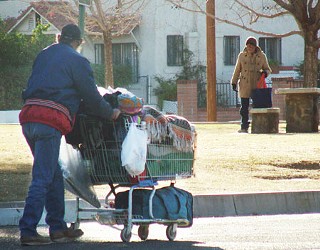After about 20 years of tracking the number of homeless people in Tucson through an annual street count, organizers with the Tucson Planning Council for the Homeless hope one small change this year will make a big difference.
In past counts, volunteers have taken to Tucson's streets at 4:30 a.m. one day in late January. A separate shelter count is done the night before, and the day count usually catches homeless people walking from campsites to service organizations.
This year, organizers decided to change the time of the Jan. 26 count from the early morning to the evening, in hopes of attracting more volunteers—and, therefore, getting a more accurate count. This could translate into an increase in the reported number of homeless people living on Tucson's streets.
Laurie Mazerbo, Teens in Transition program manager for Our Family Services, says the time change at first seemed like a big step to take. After a little research, however, she and her street count co-chair—Sylvia Cuestas, a Jackson Employment Center outreach case manager—decided it was a good idea.
"We discovered that most big cities do their counts in the evening. One benefit is that it helped them get more volunteers to participate. It's easier to ask people to come help at 6:30 p.m. than at 4 a.m.," Mazerbo says.
During the evening, Mazerbo says homeless people may actually be more noticeable.
"They are often getting what they need for the night and going to where they are going to be sleeping. Those in shelters are usually already there for the night, but those who won't go to the shelters are making their way to the washes or other places where the homeless in our city sleep," she says.
The number of people counted is expected to grow. On Jan. 29, 2009, volunteers counted 1,383 unsheltered homeless. In 2008, the number was 1,108, according to the Tucson Planning Council for the Homeless Web site.
Those figures are invaluable to those who serve the homeless—in part, because the number is tied into more than $7 million in federal funding that's split between Pima County, the city and a group of agencies that work with the homeless.
In a year when agencies and local governments have already been hit hard by state budget cuts—and are bracing for more cuts to come—the count's importance has grown, according to Linda Kot, the Primavera Foundation's deputy director.
The count is required by U.S. Department of Housing and Urban Development (HUD). Kot says the money that comes into Tucson through HUD usually helps pay for motel rooms and other assistance designed to get people off the streets and into transitional housing.
Besides the state budget cuts that have left agencies reeling, Kot says the economy is causing another stress: an increase in people needing help.
"We're seeing more families than last year," Kot says.
At the Greyhound Family Shelter, a transitional housing shelter operated by Primavera, Kot says they have 17 units—and 40 families now on a waiting list.
"All through 2009, we also saw more people in need of energy and rental assistance. Things have not changed. I would anticipate an increase in 2010," Kot says.
Mazerbo says that aside from the funding aspect, she thinks the count is important because some people don't think Tucson has much of a homeless problem.
"In a community, we should count everybody, not just people with homes and cars. In Tucson, for the most part, the weather is nice, so we have a lot of homeless people in our city. That includes a lot of kids," she says.
Mazerbo says her agency has also seen an increase in numbers of people requesting aid—especially basic needs.
"Things like toothpaste and toilet paper—not even just the big stuff. It's like if they bought any of those, it would push them over the edge," Mazerbo says.
About 90 volunteers are anticipated to help with this year's count, but Mazerbo says organizers could use 140 people to help increase the reach into all areas of the city. There is a training session on Tuesday, Jan. 19, from 11:30 a.m. to 1:30 p.m. at Caridad de Porres, 845 N. Main Ave. Those unable to go to the training can come to Jackson Employment Center (300 E. 26th St.) before 6 p.m. on the evening of the count, Kot says.
Cuestas says another benefit of changing to an evening count is that the chances increase that Operation Deep Freeze—a citywide program that creates more shelter space when the temperature drops to 35 degrees dry, or 40 degrees wet—will be in effect. And more people in shelters means a more accurate count.
Still, finding those who refuse to seek shelter, even when it is cold, can be a challenge. Mazerbo says she's putting the word out that the count needs formerly homeless people to be involved.
"They know where people are, where people are sleeping," she says. "They need to know their experience is valuable. I hope they come to help out."
For more information on the Tuesday, Jan. 26, count and volunteering, call 797-9431, or e-mail info@tpch.org.











